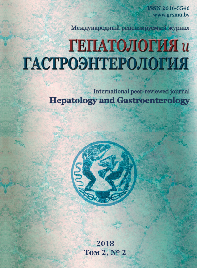DISTRIBUTION OF H.PYLORI PATHOGENITY FACTORS IN PATIENTS WITH GASTRODUODENAL DISEASES
Abstract
Background. The clinical development of Helicobacter pylori infection depends on a very complex interaction of the host and pathogen. The progression of the disease is determined by various parameters, including the genetic predisposition of the host, the bacterial genotype and environmental factors The objective of the study was to evaluate the dupA and cagPAI genes H. pylori frequency in the biopsy of patients with helicobacteriosis.
Materials and methods. The dupA and cagPAI genotypes were evaluated by PCR in 99 H.pylori-positive patients.
Results. The dupA gene was detected in 35.4% samples and its frequency was significantly greater in patients with duodenal ulcer (p < 0.05). Cag-PAI genotype distribution was as follows: cagA - 63.6%, cagL - 53.5%, cagT - 57.6%, cagE - 29.3%. The analysis showed that the cag L, cagE and cagH gene weres significantly associated with an increased risk of duodenal ulcer; the ORs (95% CI) were 3.7 (1-14.8); 5.9 (1.5-23.3) и 6.8 (1.7-27.7), respectively.
Conclusion. H. pylori dupA, cagH, and cagE genotypes have a significant link with the presence of duodenal ulcer.
References
1. Janovich OO, Titov LP, Doroshko MV. Sravnitelnyj analiz diagnosticheskih harakteristik invazivnyh metodov diagnostiki infekcii [Comparative analysis of invasive diagnostic methods for helicobacter pylori]. In: Titov LP, editor. Sovremennye problem infekcionnoj patologii cheloveka: sbornik nauchnyh trudov. Minsk: GU RNMB; 2015. Vol. 8; p.113-116. (Russian).
2. Makarenko EV, Pimanov SI, Voropaeva AV, Bondarenko VM. Rasprostranennost infektsii Helicobacter pylori v Vitebskom regione [Prevalence of Helicobacter pylori infection in the Vitebsk region]. Vestnik Vitebskogo gosudarstvennogo medicinskogo universiteta [Journal of the Vitebsk State Medical University]. 2005;4(4):12-19. (Russian).
3. Krupica JuV. Vlijanie Helicobacter pylori na razvitie zabolevanij zheludka i 12-perstnoj kishki. In: Snezhickij VA, executive editor. Sbornik materialov konferencii studentov i molodyh uchenyh, posvjashhennoj 100-letiju so dnja rozhdenija Aleksandra Zaharovicha Nechiporenko [Internet]; 2016. Аpr. 21-22; Grodno. Grodno: GrGMU; 2016. р. 464-465. Available from: http://elib.grsmu.by/handle/files/7546?show=full. (Russian).
4. Kozlovskij AA, Lozovik SK, Pokulnevich NA, Zubovich EG. Kliniko-morfologicheskie osobennosti techenija zabolevanij verhnih otdelov pishhevaritelnogo trakta u detej, prozhivajushhih v gomelskom regione [Clinical morphological features of upper digestive tract segments in children of Gomel region]. Problemy zdorovja i jekologii [Health and ecology problems]. 2013;1(35):88-92. (Russian).
5. Amieva M, Peek RM. Pathobiology of Helicobacter pylori-induced gastric cancer. Gastroenterology. 2016;150(1):64-78. doi: 10.1053/j.gastro.2015.09.004.
6. Yamaoka Y, Graham D. Helicobacter pylori virulence and cancer pathogenesis. Future Oncol. 2014;10(8):1487-1500. doi: 10.2217/fon.14.29.
7. Backert S, Tegtmeyer N, Selbach M. The versatility of Helicobacter pylori CagA effector protein functions: the master key hypothesis. Helicobacter. 2010;15(3):163-176. doi: 10.1111/j.1523-5378.2010.00759.x.
8. Yamaoka Y. Mechanisms of disease: Helicobacter pylori virulence factors. Nat. Rev. Gastroenterol Hepatol. 2010;7(11):629-641. doi: 10.1038/nrgastro.2010.154.
9. Janovich OO, Nosova ES, Titov LP, Doroshko MV, Korotkaja DI, Trus NI. Analiz genotipov ostrova patogennosti H. pylori i ih svjaz s techeniem hronicheskih zabolevanij zheludka [Analysis of the H. pylori island of pathogenicity genotypes and their association with the stomach diseases]. Zdravoohranenie [Healthcare]. 2010;10:62-65. (Russian).
10. Makarenko EV, Voropaeva AV. Geny vacA, cagA i babA Helicobacter pylori u bolnyh duodenalnoj jazvoj i hronicheskim gastritom [Helicobacter pylori genes vacA, cagA and babA in patients with duodenal ulcer and chronic gastritis]. Vestnik Vitebskogo gosudarstvennogo medicinskogo universiteta [Journal of the Vitebsk State Medical University]. 2004;3(1):74-77. (Russian).
11. Matteo MJ, Granados G, Pérez CV, Olmos M, Sanchez C, Catalano M. Helicobacter pylori cag pathogenicity island genotype diversity within the gastric niche of a single host. J. Med. Microbiol. 2007;56(Pt 5):664-669. doi: 10.1099/jmm.0.46885-0.
12. Lu H, Hsu PI, Graham DY, Yamaoka Y. Duodenal ulcer promoting gene of Helicobacter pylori. Gastroenterology. 2005;128(4):833-848.
13. Queiroz DM, Rocha GA, Rocha AM, Moura SB, Saraiva IE, Gomes LI, Soares TF, Melo FF, Cabral MM, Oliveira CA. DupA polymorphisms and risk of Helicobacter pylori-associated diseases. Int. J. Med. Microbiol. 2011;301(3):225-228. doi: 10.1016/j.ijmm.2010.08.019.
14. Fischer W, Windhager L, Rohrer S, Zeiller M, Karnholz A, Hoffmann R, Zimmer R, Haas R. Strain-specific genes of Helicobacter pylori: genome evolution driven by a novel type IV secretion system and genomic island transfer. Nucleic Acids Res. 2010;38(18):6089-6101. doi: 10.1093/nar/gkq378.
15. Zhang Z, Zheng Q, Chen X, Xiao S, Liu W, Lu H. The Helicobacter pylori duodenal ulcer promoting gene, dupA in China. BMC Gastroenterol. 2008;8:49. doi: 10.1186/1471-230X-8-49.
16. Frick-Cheng AE, Pyburn TM, Voss BJ, McDonald WH, Ohi MD, Cover TL. Molecular and structural analysis of the Helicobacter pylori cag Type IV secretion system core complex. MBio. 2016;7(1):e02001-02015. doi: 10.1128/mBio.02001-15.
17. Wiedemann T, Hofbaur S, Tegtmeyer N, Huber S, Sewald N, Wessler S, Backert S, Rieder G. Helicobacter pylori CagL dependent induction of gastrin expression via a novel alphavbeta5-integrin-integrin linked kinase signalling complex. Gut. 2012;61(7):986-996. doi: 10.1136/gutjnl-2011-300525.
18. Delahay RM, Rugge M. Pathogenesis of Helicobacter pylori infection. Helicobacter. 2012;17(Suppl 1):9-15. doi: 10.1111/j.1523-5378.2012.00976.x.
19. Backert S, Haas R, Gerhard M, Naumann M. The Helicobacter pylori Type IV Secretion System Encoded by the cag Pathogenicity Island: Architecture, Function, and Signaling. Curr. Top. Microbiol. Immunol. 2017;413:187-220. doi: 10.1007/978-3-319-75241-9_8.
20. Wang F, Meng W, Wang B, Qiao L. Helicobacter pyloriinduced gastric inflammation and gastric cancer. Cancer Lett. 2014;345(2):196-202. doi: 10.1016/j.canlet.2013.08.016.
21. Baryshnikova NV. Helicobacter pylori-associated gastroenterological diseases: genetic features and probiotic treatment. Benef. Microbes. 2012;3(2):157-161. doi: 10.3920/BM2011.0023.
22. Alm RA, Trust TJ. Analysis of the genetic diversity of Helicobacter pylori: the tale of two genomes. J. Mol. Med. 1999;77(12):834-846.
23. Shiota S, Matsunari O, Watada M, Hanada K, Yamaoka Y. Systematic review and meta-analysis: the relationship between the Helicobacter pylori dupA gene and clinical outcomes. Gut Pathog. 2010;2(1):13. doi: 10.1186/1757-4749-2-13.
24. Gomes LI, Rocha GA, Rocha AM, Soares TF, Oliveira CA, Bittencourt PF, Queiroz DM. Lack of association between Helicobacter pyloriinfection with dupA positive strains and gastroduodenal diseases in Brazilian patients. Int. J. Med. Microbiol. 2008;298(3-4):223-230. doi: 10.1016/j.ijmm.2007.05.006.
25. Nguyen LT, Uchida T, Tsukamoto Y, Kuroda A, Okimoto T, Kodama M, Murakami K, Fujioka T, Moriyama M. Helicobacter pylori dupA gene is not associated with clinical outcomes in the Japanese population. Clin. Microbiol. Infect. 2010;16(8):1264-1269. doi:10.1111/j.1469-0691.2009.03081.x.


















1.png)






